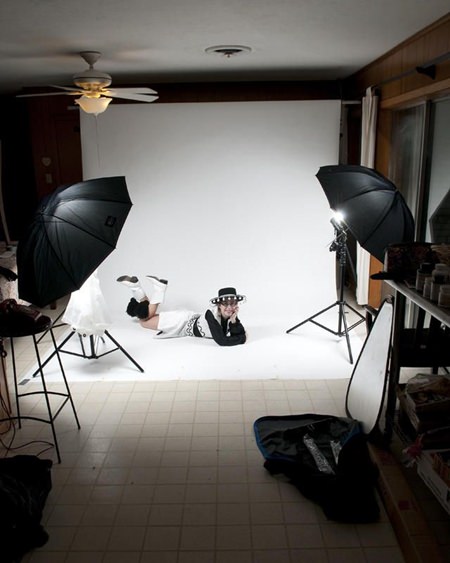
As I went further into commercial photography, it became obvious that the clients expected me to have a studio. This was not to be just a hole in the wall with a flash head on a tripod, but would have a cyclorama (seamless background), a discussion area to meet clients and a dressing room when models were necessary.
I was lucky and found a very large area in an old disused factory that I could use, partition and plumb. It had windows along two sides and other walls were painted white. It was certainly light and airy.
I built the cyclorama (cyc) myself, painted it white, and did the trick as far as those seamless shots were required. The colored seamless background paper I hung over the cyc. Two very large boards on wheels (about 2 m x 2 m) were made – white on one side and black on the other. I was almost ready for some heavy duty clients.
Lighting was courtesy of three Broncolor heads, one with its own soft box, while the other two fired into triangular diffuser/reflectors. All these I also made myself, so financial outlay was minimal.
With everything new (secondhand) I began to take some test shots. Now came the first snag. The studio was so bright and airy, it became difficult to get enough power in the Brons to overcome the ambient light.
Neutral density filters were required, and this was fine for still life subjects but not for fashion shots. To handle the amount of light it also became necessary to use the fastest shutter speed, and whilst 35 mm cameras can go to 1/2000 this is not the same for medium format or large format, the bulk of my shooting.
I struggled with the problem for a year, but when the eviction notices were handed out, I began to look for a studio which was not quite so bright and airy. Once again it was a disused factory, but this space had no windows. From a white studio, I went into a black studio.
Where before I was trying to get rid of all extraneous light, with this new studio it was a case of adding light. And that was a significant improvement compared to before. I could put my light exactly where I wanted it, and the strength of the light as it fell on the subject was again under my control.
There were a few drawbacks. Sometimes it was very difficult to get enough light on the subject, so multiple flashing was sometimes necessary. With each exposure it was a case of counting down the aperture values. Flash, f22; flash, f 16; flash, f 11; flash f 8. Any movement ruins the shot, of course, and the more times you flash, the more likely it is that there will be some problem.
The internal modeling lights in the Brons became more important, to see where the light was falling, where in the white studio the ambient washed out anything from the modeling lights. I also found that the lights in two of the Brons were blown! Something not noticeable in the white studio.
Since we had to have extra lights just to find items for work, an assistant was needed to turn working lights on and off, which was a problem at times too.
The large reflector boards became used every day, but only the white side to the subject!
On looking back at the two studios, there was no doubt about the superiority of the black studio. The photographer was in control right from the start, where in the white studio, the photographer was playing catch-up trying to get over the basic problems of too much light. The downside of the black studio came in the need to upgrade the Brons to be able to illuminate dark corners!
If you are an amateur photographer, you can always make your own studio at home, but go for black, and not a white one!
 |
 |
 |





